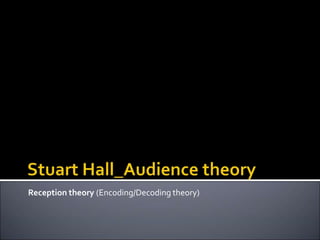
Stuart Hall's Reception theory
- 1. Reception theory (Encoding/Decoding theory)
- 2. Stuart McPhail Hall (3 February 1932 – 10 February 2014) was a Jamaican born cultural theorist and sociologist who lived and worked in the United Kingdom from 1951. Hall, along with Richard Hoggart and RaymondWilliams, was one of the founding figures of the school of thought that is now known as British Cultural Studies orThe Birmingham School of Cultural Studies.[1]
- 3. Dominant-hegemonic reading: A ‘preferred reading’ that accepts the text’s messages and the ideological assumptions behind the messages. The dominant view and what the creator wants you to see. Oppositional Reading: The complete opposite reading to what the creator had intended. The reader rejects both the overt message and its underlying ideological assumptions. Negotiated Reading: An understanding of the dominant reading but can also see it from other perspectives. The reader accepts the text’s ideological assumptions, but disagrees with aspects of the messages, so negotiates the meaning to fit with their ‘lived experience’ Aberrant Reading: Completely reject the product as the reader has no view at all on the matter.
- 4. According to Stuart Hall, there are three main ways which audiences take about media representation. They are called views: The intentional view The reflective view The constructionist view
- 5. Role of a text according to its institution-audience relation: Active institutional view: Message transmitted from institution (active emitter) to audience (passive receiver), which accepts the preferred reading (the one which the media producers want the audience to receive) Negotiated view:The institution encodes a meaning into the text which the audience interprets in relation to other factors (i.e. knowledge of previous similar texts) Meaning is ‘negotiated’ between institution and audience. Active audience view:The meaning is re-created by the audience (active receiver).The institution becomes passive since it has no control over how the audience re-creates the meaning of that text.
- 6. This time the most important thing in the process of representation is the institution presenting its view of whatever they are representing through a very specific use of words or images which are intended to be read in a literal way (Passive audience) According to this theory, if you see a picture of an attractive person drinking a can of Coke in an advert, it will have the same meaning to you as the advertiser intended: “go and buy a can of Coke, because this is what the cool people drink!”
- 7. According to this view, when the media represents something, the audience are taking the text’s literal meaning and trying to create in their minds a replica of it, like a reflection. (Passive audience) This is the view that many people have of how news works: “the news producers take the “truth” of news events and supposedly present it to us as “accurately” as possible” or, using the previous example, “I’ll go and buy a can of Coke, because this is what the cool people drink!”.
- 8. Any representation is a mixture of: The nature of the matter represented (itself). The ideology of the people producing the representation. The reaction of the audience to the representation. The context (hegemonic ideology) of the society in which the representation is taking place. This is really a response to what have been seen as weaknesses in the other two theories- constructionists think that a representation can never just be the truth or the version of the truth that someone wants you to read since that is ignoring your subjectivity as an individual when reading the text, and your ability to make up your own mind (active audience) as well as the influences of the society that you live in on the way that you do so.
- 10. Useful questions we can ask ourselves when deconstructing a media text from the perspective of the media organisation behind the text (encoding/mediation process): Who constructed this text?What is the ideology of this media organisation?What other similar texts have they constructed? In what context was this text constructed?What do we know about the time and place where this text was constructed? Is this a typical text of its socio-cultural and historical context? What representations are being used in this text to create meaning? What meaning has been encoded into the text?
- 11. Useful questions we can ask ourselves when deconstructing a media text from the perspective of its audience (decoding process): Who is this text aimed at? (Who is the target audience?) What assumptions are made about the audience which are revealed in the text’s construction? Where and when is the audience likely to receive the text? How does this influence the form and structure of the text? How will this audience ‘read’ this text?
- 12. How does this text conform to audience expectations? What previous experience or knowledge does the audience refer to when consuming this text? How does the audience create meaning from this text? How and where might an audience receive this text? How might this influence the meaning they receive?
- 13. Write a 500-800 words essay analysis answering the previous questions and applying at least two of the audience theories studied, articulating these with at least two of the representation theories studied: Audience theories studied that could be suitable in the analysis of these cases of study: Effects theory Social cognitive theory Cultivation theory Reception theory The uses and gratifications theory Representation theories studied that could be suitable in the analysis of these cases of study: Stuart Hall’s stereotypes and symbolic power theory Paul Gilroy’s Post colonial melancholia theory